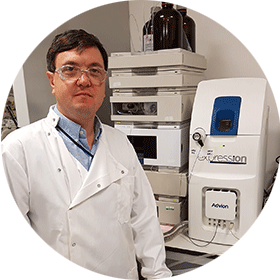Membrane-enclosed multienzyme (MEME) synthesis of 2,7-anhydro-sialic acid derivatives
Marie Monestier, Dimitrios Latousakis, Andrew Bell, Sandra Tribal, Louise E. Tailford, Ian J. Colquhoun, Gwenaelle Le Gall, Hai Yu, Xi Chen, Martin Rejzek, Simone Dedola, Robert A. Field, Nathalie Juge
 Naturally occurring 2,7-anhydro-alpha-N-acetylneuraminic acid (2,7-anhydro-Neu5Ac) is a transglycosylation product of bacterial intramolecular trans-sialidases (IT-sialidases). A facile one-pot two-enzyme approach has been established for the synthesis of 2,7-anhydro-sialic acid derivatives including those containing different sialic acid forms such as Neu5Ac and N-glycolylneuraminic acid (Neu5Gc). The approach is based on the use of Ruminoccocus gnavus IT-sialidase for the release of 2,7-anhydro-sialic acid from glycoproteins, and the conversion of free sialic acid by a sialic acid aldolase. This synthetic method, which is based on a membrane-enclosed enzymatic synthesis, can be performed on a preparative scale. Using fetuin as a substrate, high-yield and cost-effective production of 2,7-anhydro-Neu5Ac was obtained to high-purity. This method was also applied to the synthesis of 2,7-anhydro-Neu5Gc. The membrane-enclosed multienzyme (MEME) strategy reported here provides an efficient approach to produce a variety of sialic acid derivatives.
Naturally occurring 2,7-anhydro-alpha-N-acetylneuraminic acid (2,7-anhydro-Neu5Ac) is a transglycosylation product of bacterial intramolecular trans-sialidases (IT-sialidases). A facile one-pot two-enzyme approach has been established for the synthesis of 2,7-anhydro-sialic acid derivatives including those containing different sialic acid forms such as Neu5Ac and N-glycolylneuraminic acid (Neu5Gc). The approach is based on the use of Ruminoccocus gnavus IT-sialidase for the release of 2,7-anhydro-sialic acid from glycoproteins, and the conversion of free sialic acid by a sialic acid aldolase. This synthetic method, which is based on a membrane-enclosed enzymatic synthesis, can be performed on a preparative scale. Using fetuin as a substrate, high-yield and cost-effective production of 2,7-anhydro-Neu5Ac was obtained to high-purity. This method was also applied to the synthesis of 2,7-anhydro-Neu5Gc. The membrane-enclosed multienzyme (MEME) strategy reported here provides an efficient approach to produce a variety of sialic acid derivatives.
The MS analysis was carried out using Advion Expression® CMS ESI.
A simple cleft shaped hydrazine-functionalized colorimetric new Schiff base chemoreceptor for selective detection of F− in organic solvent through PET signaling: Development of a chemoreceptor based sensor kit for detection of fluoride
Additi Roy Chowdhury, Biswajit Gopal Roy, Saibal Jana, Thomas Weyhermuller, Priyata Banerjee
Novel colorimetric hydrazine-functionalized Schiff base chemoreceptor [N1N3bis(perfluorobenzylidene)isophthalahydrazide] NBPBIH has been prepared for selective detection of F−. In this receptor more NH and C
The MS analysis was carried out using Advion Expression® CMS ESI.
Hydrazine functionalized probes for chromogenic and fluorescent ratiometric sensing of pH and F−: experimental and DFT studies
Additi Roy Chowdhury, Amita Mondal, Biswajit Gopal Roy, Jagadeesh C. Bose K, Sudit Mukhopadhyaye and Priyabrata Banerjee
Two novel hydrazine based sensors, BPPIH (N1, N3-bis(perfluorophenyl)isophthalohydrazide) and BPBIH (N1′, N3′-bis(perfluorobenzylidene)isophthalohydrazide), are presented here. BPPIH is found to be a highly sensitive pH sensor in the pH range 5.0 to 10.0 in a DMSO–water solvent mixture with a pKa value of 9.22. Interesting optical responses have been observed for BPPIH in the above mentioned pH range. BPBIH on the other hand turns out to be a less effective pH sensor in the above mentioned pH range. The increase in fluorescence intensity at a lower pH for BPPIH was explained by using density functional theory. The ability of BPPIH to monitor the pH changes inside cancer cells is a useful application of the sensor as a functional material. In addition fluoride (F−) selectivity studies of these two chemosensors have been performed and show that between them, BPBIH shows greater selectivity towards F−. The interaction energy calculated from the DFT-D3 supports the experimental findings. The pH sensor (BPPIH) can be further interfaced with suitable circuitry interfaced with desired programming for ease of access and enhancement of practical applications.
The MS analysis was carried out using Advion Expression® CMS ESI.

New Path Molecular Ltd, United Kingdom
Q: WHAT IS THE FOCUS OF YOUR LAB’S RESEARCH?
A: New Path Molecular Ltd is focused on the development and implementation of high performance enabling technologies to assist the chemical and pharmaceutical industries. We develop and implement solutions for customers who are looking to develop or improve chemical steps or routes utilizing state of the art technologies.
Q: WHAT WAS YOUR PREVIOUS WORKFLOW AND EXPERIENCED CHALLENGES?
A: Previously we only had access to mass spectrometry facilities through an external vendor. Whilst these were first class, analysis was slowed as the facilities were not on site.
Q: WHY DID YOU INCORPORATE THE EXPRESSION® CMS INTO YOUR LABORATORY?
A: Within a small but expanding group the expression® CMS meets our requirements for an instrument that is intuitive to use, robust and capable of being maintained, expanded and serviced without manufacturer call outs. The expression® CMS combines solid performance at a reasonable price and without excessive maintenance costs. For us the instrument is ideal for day to day laboratory analysis.
Q: TO WHOM WOULD YOU RECOMMEND THE EXPRESSION® CMS?
A: All chemists looking for a robust easy to use mass spectrometer that does not require extensive work to keep the instrument in service and that will give solid performance in day to day laboratory analysis tasks.
Peptide-Based Materials for Controlled Delivery of Hydrogen Sulfide
Shared live at the 254th ACS National Meeting in Washington, D.C. –
John Matson, Ph. D., Matson Research Group on Macromolecular and Supramolecular Chemistry, Assistant Professor, Virginia Tech.
Listen to the recorded workshop session highlighting the role of H2S in the human body and how compact mass spectrometry is used to assay peptides via direct injection for reaction monitoring, and coupled with HPLC for purification.
Peak Express™: Software for the Synthetic Organic Chemist
Introducing a new type of mass spectrum, available exclusively in the Advion Peak Express™ software suite: the Delta Spectrum (ΔS). The ΔS is available with the expression® compact mass spectrometer (CMS) to look beyond chemical noise and automatically detect even the smallest peaks without knowing the m/z in advance.
With the Peak Express™ software featuring ΔS, you can:
- Obtain clear detection of peaks without knowing their mass
- Find adducts, dimers, fragments, side-reactions and other unexpected compounds at the click of a button, in real-time or with post-processing
- Highlight minor components in complex mixtures and dirty matrices
- Control mass-directed purification without providing the compound mass
- Acquire XIC-quality data while scanning the entire mass range, allowing Peak Express™ to tell you the m/z
A metabolite profiling method for diagnosis of precancerous cervical lesions and HPV persistence
The data collected from the analysis on the portable Advion CMS were treated in exactly the same way as the data collected from the Waters LCT and although the mass resolution and sensitivity of the two instruments is different the same clustering patterns were seen in the PCA scores plots. The PCA loadings plots also showed the same patterns with the same major 385.4 mass bin responsible for the separation of the classes seen in the scores plots.
The findings are important because they suggest that metabolite profiling could offer an accurate, and time-effective tool for identifying women at increased risk of HPV persistence. Current screening for cervical cancer risk relies, as a first step, on a cytological assessment which can be difficult to classify at the low-grade end of cervical cell abnormality and currently there is no screening tool for predicting HPV persistence. Metabolite profiling therefore has the potential to improve existing screening methods for cell abnormality and to supplement information about HPV positivity; the critically important risk factor for cervical cancer.
From Bioanalysis, Published May 2017
University of Cambridge, Ley Group
Q: WHAT IS THE FOCUS OF YOUR LAB’S RESEARCH?
A: One of the focus points for Ley Group research is the development of continuous flow synthesis methods. We aim to include new enabling techniques into our work to facilitate the collection of data relevant to the reactions we conduct. We work across the early synthesis spectrum – from discovery to scale-up and process development.
Q: WHAT WAS YOUR PREVIOUS WORKFLOW AND EXPERIENCED CHALLENGES?
A: Standard detectors we use in our work can be problematic when trying to discern what is in a product mixture leaving a flow reactor. For example, UV detectors are useful only in very restricted flow-based situations and don’t give compositional information. IR is a step up from this, but suffers from issues when peaks in starting materials, products and by-products overlap. Some transformations may also lead to undetectable changes in an IR spectrum. While flow-based NMR can be good when it’s usable, its expense and lack of resolution at a bench-top level hinder its utility.
Q: WHY DID YOU INCORPORATE THE EXPRESSION® CMS INTO YOUR LABORATORY?
A: The expression® CMS struck the perfect balance between cost, ease-of-use and detection capabilities that we needed for our research. We’re able to get large amounts of relevant information about reaction mixtures, in real-time, without worrying in most cases about overlapping peaks or detection signals. This information is used by our control systems to make decisions about product stream composition, allowing us to automate procedures such as reaction telescoping, process start up and self-optimization. The expression® CMS software is fantastic also – everything is recorded, letting us go back over the raw data to gain even more insights into how product compositions change over time in our processes.
Q: TO WHOM WOULD YOU RECOMMEND THE EXPRESSION® CMS?
A: I would recommend the system to any group that works with continuous flow chemistry, especially those that need real-time analysis of stream compositions. The ease at which the unit can be integrated into any process makes it an extremely attractive unit to use. It’s also very easy to switch the expression® CMS into a standalone MS unit for independent sample analysis, making it versatile in any organic chemistry laboratory.
Q: HAVE YOU CONTRIBUTED TO ANY PUBLICATIONS USING THE EXPRESSION® CMS?
A: Org. Process Res. Dev., 2016, 20, 386–394
Quant Express – Mass Express 4.0 Software with Quantitation
Quant Express, an addition to Advion’s user-friendly Mass Express 4.0 software suite, features quantitation to create a fully integrated software system for expression CMS users.



